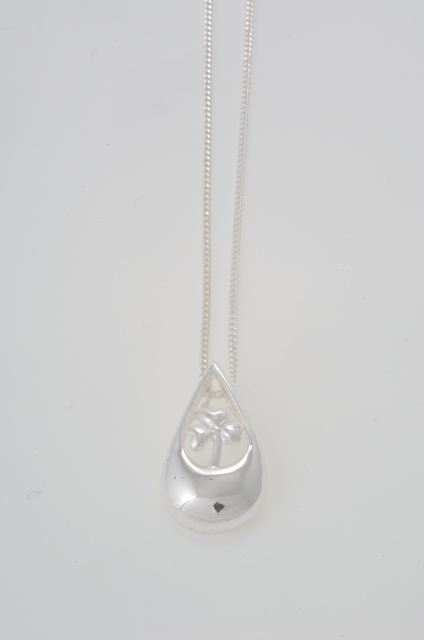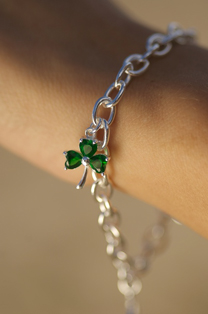Irish Shamrock
Shamrock is just Clover right?
Shamrock
There is a lot of horticultural stuff written on the web about the Shamrock and attempts to identify which species of clover is actually the ‘true Shamrock'. I thought i wouldn't get into the whole horticultural debate rather just link to it...
- The Shamrock : A Further attempt to fix its species, by Nathaniel Colgan, published in the Irish Naturalist 1893 on the From Ireland web site. Retrieved 2008-07-20
- The truth behind the shamrock on the BBC News website, dated 17 March 2004. Retrieved 2008-07-20
And give you the bottom line
The common consensus is that Trifolium repens is most likely suspect.....
"Those most commonly called shamrocks are: the white clover, Trifolium repens, a creeping white-flowered perennial..." Collier's Encyclopedia, Vol. 20, 1992.
So yes its just Clover really!!
Silver Shamrock Pendant

The word Shamrock is derived from the diminutive version of the Irish word for "clover" ("seamair") is "seamróg", which was anglicised as "shamrock". seamrog is pronounced sham rogue. Og actually means young. So young clover would arguably be the more correct translation, and that would make sense if you read below about growing shamrock. Clover looks like/or is Shamrock when the leaves are small and new. Well that's what i think anyway and I know nothing!!
Silver Shamrock Charm on A Celtic Charm Bracelet

Use of Shamrock and the Shamrock Symbol in Ireland today
Although the shamrock did not used to be the official Irish emblem it is probably the most recognised Irish emblem in the world. The Harp was the official Emblem and is used on coinage and official Government stamps. Both the Shamrock and the Harp were officially registered as Irish Trade marks in 2003
^ Use of the harp and the shamrock were registered by the Irish government as international trademarks. See Record of the meeting of the Joint Oireachtas Committee on Enterprise and Small Business, 26 March 2003. Retrieved 2008-07-20.
The shamrock symbol is very heavily used in Ireland, even out side of St Patricks day. The national airline Aer Lingus has a Shamrock emblem on its Tail fin in fact Shamrock is the ATC call sign of Aer Lingus. An Bord Failte (the Irish tourist Bord).Sports logos such as The IRFU and Shamrock Rovers
On St Patricks day the shamrock is everywhere. My children age 5 and 4 bring home their shamrock artwork from school and my parents wear shamrock on their coats going to mass. Despite all the fuss about which clover is the real shamrock , the shamrock we wore on our coats was bought in the shop ( and was wilted and half dead). It was smaller and neater than regular garden clover and not at all like anything I have ever seen growing wild. So when people talk of ‘the real Shamrock' do they mean what our ancestors wore? Or what St Patrick was said to have used to symbolise the Hoy Trinity? I can't imagine it was anything other than common field clover! Saying that Seamrog means small or young clover?? The answer may lie in the passage below from http://www.tippitiwitchet.co.uk/shamrock.html about growing shamrock...be warned its not that lucky...more weedy
Gold Celtic Jewelry Shamrock pin Brooch

Growing Shamrock
GROWING SHAMROCK
It is frequently repeated that shamrock will not grow in any soil but Irish soil. This is nonsense. Each of the clovers worn as shamrock grows outside Ireland as a wild plant, in Britain, Europe, and farther afield too. You can collect shamrock anywhere, almost everywhere.
Shamrock seed is frequently sold in souvenir shops - it will be lesser clover, skilfully packaged and marketed to beguile. It will grow quickly and easily in any good garden loam or in any artificially-produced potting compost that contains lime. It does not need to be cultivated indoors; indeed it is best to grow it outside.
As a general rule, clovers do not flourish in acid, wet soils. Seed sown out-of-doors in late summer (August) will germinate and be ready to harvest on St Patrick's Day the following year. Seed sown in autumn (October) in a cold greenhouse will also be a suitable size for use too.
If left to grow, shamrock will take on the full characteristics of the parental clover, producing vigorous shoots, larger leaves and forming clumps up to half a metre across. They will bloom in summer with small yellow flowers (lesser clover, black medick), white flowers (white clover), crimson flowers (red clover). Furthermore they will become pestilential weeds if allowed to seed and spread - white clover will be the worst as it can spread rapidly by 'runners'.
Various peculiar variants of the clovers are treasured as garden plants. St Patrick's Tears was a name used last century for the purple- and multi-leafleted form of white clover (Trifolium repens 'Purpurascens Quadrifolium'). There is a more elegant (but equally weedy) golden veined red clover (Trifolium pratense 'Susan Smith').
If you would like to cultivate an elegant plant, shamrock-like, may I recommend Parochetus communis which has wonderful rich blue pea-like flowers. A native of the Himalaya, at least it belongs to the right family unlike wood sorrel and the various cultivated forms of Oxalis which are frequently called - incorrectly - shamrock. In America they are even marketed as shamrock. These can be equally weedy, particularly forms of Oxalis corniculata. They do make fine garden subjects, but if they set seed will become ineradicable weeds.
Don't say you were not warned!
Gold Shamrock Pendant

Is Shamrock Lucky?
The four-leaf clover is often confused with the shamrock. While the four-leaf clover is a symbol of good luck because as it is a mutation it is rare to find one. The three-leafed shamrock is mainly an Irish Christian symbol of the Holy Trinity and has a different significance. However The Irish Shamrock and the luck of the irish seem to have blended and 3 leaved shamrocks now seem to be seen as a symbol of luck.
Gold Shamrock Ring

How to wear shamrock
Growing up we pinned shamrock on our coats going to mass on St patricks day. But it seems it was origionally worn on hats.
Royal Irish Regiment soldiers wear a sprig of Shamrock on Saint Patrick's Day as it is their emblem. Shamrock are exported to wherever the regiment is stationed throughout the world. Queen Victoria decreed over a hundred years ago that soldiers from Ireland should wear a sprig of shamrock in recognition of fellow Irish soldiers who had fought bravely in the Boer War, a tradition continued by British Army soldiers from both the north and the south of Ireland after partition.
To this day on St. Patrick's day every year Shamrock is presented to members of the Regiment and is worn on their head-dress called a Corbeen. It does not matter where the
regiment is the tradition is upheld, and it is not unheard of for Shamrock to be flown to the USA, Germany or other parts of the world so that it is available.
A famous painting by Sir Joshua Reynolds shows Lord Charlemont with a clump of shamrock in his hat, and when he paid a visit to Ireland in 1820, King George IV entered Dublin standing in his carriage, pointing ostentatiously to a large sprig adorning his hat.
"The St Patrick story was first recorded in 1726 in a book about the wild flowers of Ireland written by an English dissenting (protestant) cleric, Dr Caleb Threlkeld, who recorded that:
' This Plant [white clover] is worn by the People in their Hats upon the 17. Day of March yearly (which is called St. Patrick's Day.) it being a Current Tradition, that by this Three Leafed Grass, he emblematically set forth to them the Mystery of the Holy Trinity.'"
The Legend of St Patrick and the Shamrock
St Patrick and the Shamrock
My father explained the St Patrick and the Shamrock story to me when i was young as follows. Before Christianity arrived in Ireland was populated largely with Celts. The number 3 was filled with meaning for Celts. Many aspects of Celtic life and beliefs had a three fold structure. For example the tribal structure was threefold, the Warrior aristocracy, The priestly class (Druids) and the farmer class. Also their King was seen as an earthly representative of God and their God was married to The Goddess of the land.
St Patrick was on a mission to convert the Celts to Christianity and to do this he set out to convert pagan customs into Christian. One of these was to use the Shamrock to illustrate the holy Trinity and the belief that the Father son and the Holy Ghost combine to Form the one god just as the 3 leaves of the shamrock combine into one leaf. Similarly the Celtic festival of Samhain was converted to a Christian celebration of all hallows eve (but that change was attributed to Pope Boniface).
However it really looks like more of a legend than historical fact as there is no mention of anything in St Patrick's writings and Historians say the first written references to "shamrocks" as part of St. Patrick's Day celebrations don't appear until the early 18th century, 1200 years after his death.
Beautifull shamrock jewelry
- Irish Celtic Shamrock Jewelry
Gold and Silver Shamrock Jewelry celtic, Shamrock earrings, shamrock rings, shamrock pin brooch, shamrock pendants









